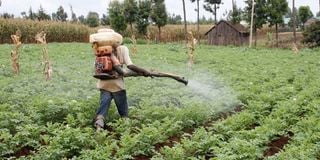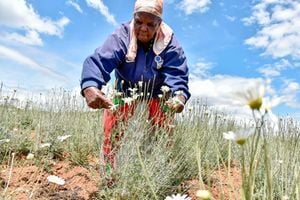Cancer-causing chemicals found in pesticides used in Kenya

A farm worker sprays a potato farm with pesticides and herbicides in Elburgon, Nakuru County in this photo taken on November 17, 2022.
What you need to know:
- Thirty-four per cent of the pesticides registered by the PCPB in Kenya are withdrawn from the European market or are heavily restricted due to potential chronic health effects, environmental persistence and high toxicity towards fish or bees.
- Only only one in six farmers wear full protective gear when applying pesticides.
Nine active ingredients in pesticides registered for use in Kenya have been linked to at least six types of cancer - leukemia, non-Hodgkin’s lymphoma, bladder, colon, lung, and pancreatic cancers. All these ingredients are contained in pesticides regulated by the Pest Products and Control Board (PCPB).
The active ingredients include glyphosate, present in Roundup, Atrazine, Boscalid, Dimethomorph, Dicamba, Dimethonamid, Dinotefuran, Imazethapyr, and Metolachlor. They are present in pesticide and pest control products used in the production of maize, onions, broccoli, tomatoes, French beans, melons, sugarcane, tea, wheat, barley, common beans and roses.
In a study published in the Frontiers Cancer Control Society, health experts explained that exposure to these active ingredients can deplete the body's antioxidants - vitamins and elements that remove potentially damaging agents from the body. This, in turn, can damage one's DNA and disrupt the processes through which a cell interacts with itself, other cells, and the environment.
This leads to mutations, alterations in gene expression, and, ultimately, carcinogenesis - the process by which normal cells are transformed into cancer cells.
Primary exposure to the pesticides can happen through eating food or drinking water contaminated with them, with the level of contamination depending on the toxicity of the pesticide, measures taken during its application, dosage applied, weather conditions prevailing after application, and how long the pesticide persists in the environment.
While some individual pesticides have been associated with cancer, the study highlights that mixtures of pesticides—as they are usually applied to crops—greatly increase the risk of cancer. This risk extends beyond agricultural regions, with many communities at the highest risk affected by hazardous pesticides carried through the air and water from nearby farms.
Health experts who authored the study linked exposure to glyphosate to an increased risk of lymphoma, a type of blood cancer that affects the immune system, colon and pancreatic cancers.
According to PCPB, glyphosate is a herbicide mainly used in Kenya to control weeds before planting seasons. The chemical is also used to control annual perennial grasses and broadleaf weeds in tea.
Atrazine, which was consistently marked as a top contributor in regions with high added risk for all cancers and colon cancers, is used in Kenya as a pre-emergence herbicide for control of broadleaved weeds and annual grasses in maize. The World Health Organization (WHO) classifies this herbicide as moderately hazardous.
Boscalid, a fungicide used in the country to control powdery and downy mildew on roses, and post-harvest treatment of roses, was linked to leukemia, non-Hodgkin's lymphoma, and pancreatic cancer.
“Dimethomorph was representative of not only regions with a high added risk of leukemia and non-Hodgkin's lymphoma but also regions with a low added risk of colon cancer," says the study. This fungicide, classified as slightly hazardous, is used to control Downy mildew on roses, onions and broccoli and early and late blight in tomatoes, rust on French beans and downy mildew in melons. When used on French beans, farmers are required to wait at least three days before harvesting the crop. The waiting period for onions and broccoli is seven days, while that of water melons is 14 days.
Dicamba, used as a post-emergence herbicide for control of annual grasses and broad-leaved weeds in maize, was consistently at the top of the list in regions with a high added risk of colon cancer and pancreatic cancer. Even though it is classified as a slightly hazardous chemical, farmers, upon using it, are expected to wait 60 days before harvesting the crop.
Dimethenamid was linked to risk of bladder cancer. When combined with dimethenamid-P, it increased the risk of developing pancreatic cancer. The ingredient is used in herbicides for control of broad-leaved weeds and annual grasses in sugarcane. Once applied, farmers must wait 38 days before harvesting.
Dinotefuran, an active ingredient in insecticides used for the control of aphid, white flies and caterpillars on roses, was at the top in regions with high leukemia and non-Hodgkin's lymphoma.
Imazethapyr, used to control annual grasses and broadleaved weeds in common beans, had a similar presence in all cancers, colon cancer and lung cancer.
Metolachlor, metolachlor-S, used to control annual grasses and broad leaved weeds in maize, was linked to colon and pancreatic cancers.
Besides cancer incidences, Ibrahim Macharia, a senior lecturer at the Department of Agricultural Economics at Kenyatta University, established in 2015 that pesticide-related health impairments among farmers increased alongside increased pesticide application. The study is published in The Conversation. The impairments include sneezing, dizziness, headache and blurred vision, and skin irritations.
In September 2023, Route to Food in partnership with Heinrich Boll Foundation in Kenya published a report showing that during the 2020 reporting period, farmers used 310 pesticide products containing 151 active ingredients.
The farmers also applied a total of 3,068 tonnes of pesticide products to control insects, diseases and weeds on 26 different crops. They spent a Sh9.4 trillion on pesticide products. Out of this, Sh3.6 trillion went to insecticide purchases, Sh3.4 trillion on herbicides (led by glyphosate and paraquat), and Sh2.3 trillion on fungicides (led by mancozeb).
“Out of the 310 pesticide products used, 195 products (63 per cent) contained one or two active ingredients that are categorised as highly hazardous chemicals, accounting for 76 per cent of the total volume of pesticides used. Notably, almost half (44 per cent) of the total volume of pesticides used in Kenya are already banned in Europe due to their unacceptable risk to human health and the environment,” said the Route to Food report.
The report also warned that farmers in Kenya heavily use highly hazardous pesticides in growing maize, wheat, coffee, potatoes and tomatoes. Due to their environmental toxicity and widespread usage, the European Union has banned some pesticides for use in Europe.
According to the Food and Agriculture Organisation and WHO, highly hazardous pesticides present high levels of acute or chronic hazards to human health and the environment. Such pesticides are also linked to severe or irreversible harm.
"Pesticides are highly hazardous if they have an acute lethal effect, cause cancer or genetic defects, impair fertility, or harm unborn children. Likewise, pesticides are classified as highly hazardous if they cause serious or irreversible damage to health or the environment under normal conditions of use," says the report.
"Based on their potential human health toxicity, considering factors such as carcinogenicity, reproductive toxicity, endocrine disrupting activity, mutagenicity, and neurotoxicity, several active ingredients require urgent regulatory measures. The most toxic and commonly used ingredients are the insecticide chlorpyrifos, the herbicides acetochlor, glyphosate and 2.4-D, and the fungicides mancozeb and chlorothalonil," the report warned.
"Even if some insecticides have low application volumes, it is crucial to regulate and withdraw these substances due to their demonstrated high levels of human or environmental toxicity."
The report implicated 73 companies for the pesticide products sold in Kenya, including Syngenta, leading the pesticides market with a 20 per cent market share, Bayer AG with 15 per cent, Corteva Agriscience™ with 7.7 per cent, FMC Corporation with 5.7per cent and Adama Agricultural Solutions with 4.4 per cent.
"Syngenta, headquartered in Switzerland, sells 40 products with the highest volume of pesticides in Kenya (544 tonnes), of which 68per cent are highly hazardous pesticides. The top three products in terms of volume contain glyphosate, paraquat (banned in Europe), metalaxyl and mancozeb (banned in the EU)," said the report.
It added: "Bayer AG, a German company, sells 39 products with a total volume of 286 tonnes, of which 84 per cent are highly hazardous pesticides. Their top-selling product in terms of volume contains glyphosate, while the top- selling product in terms of value is the insecticide Thunder, containing beta-cyfluthrin and imidacloprid (both banned in the EU).
In total,171 companies have registered 862 products in Kenya. Most of the products originate from China (342 products), followed by Europe (253).
Although there are 36 different European companies, more than half of the registered products (57 per cent) are sold by BASF, Bayer AG, and Syngenta.
Thirty four per cent of the pesticides registered by the PCPB in Kenya are withdrawn from the European market or are heavily restricted due to potential chronic health effects, environmental persistence and high toxicity towards fish or bees.
Only one in six farmers wear full protective gear when applying pesticides.
Only 15 out of every 100 farmers in Kenya store pesticides in a safe place away from children.





